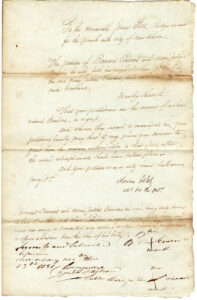Marie Couvent
Marie Couvent, also known as Marie Justine Cirnaire, was a wealthy free woman of color in New Orleans who donated property for use as a free school.

NEW ORLEANS PUBLIC LIBRARY
Emancipation petition of Bernard Couvent and Marie Justine Cirnaire, 1821.
Marie Couvent, also known as Marie Justine Cirnaire, was a wealthy free woman of color in New Orleans who donated property for use as a free school. In her will, Couvant stipulated that her property at 1941 Dauphine Street, in the Faubourg Marigny, be used for the benefit of the orphans in her neighborhood. Since her death in 1837, her original property has continually served a space for the education of thousands of African American children.
Born in Africa around 1757, Couvent was enslaved as a child and shipped from the Bight of Benin to Saint Domingue in the 1760s. During the Saint Domingue Revolution (also know as the Haitian Revolution), Couvent, like many other refugees, fled the island and resettled in New Orleans. It remains unclear exactly how she gained her freedom, but by 1806 she purchased two pieces of land in New Orleans as a free woman. On October 27, 1812, she married Bernard Couvent, a free black carpenter. Their only children came from previous relationships. Like many free people of color in New Orleans, Couvent spoke French and attended Catholic mass. She also owned at least twenty-three slaves during her lifetime. With the aid of her female slaves, Couvent probably sold textile goods in the market. She emancipated three of these enslaved women but owned five other slaves at the time of her death. Couvant died in New Orleans, on June 28, 1837, about eight years after her husband, who died May 22, 1829.
Although she was illiterate, Couvent’s will stipulated that her property be “used in perpetuity for the establishment of a free school for the colored orphans of the Faubourg Marigny” under the auspices of Father Constatine Maenhaut. After her death, a group of prominent free men of color created L’Institution Catholique pour l’Instruction des Orphelins dans l’Indigence, which opened in 1848. During the next century, four distinct schools existed at this location. The fourth incarnation, Bishop Perry Middle School, closed following Hurricane Katrina. Today, the St. Gerard Majella Alternative School operates on Couvent’s property.
While none of these schools bore the name of the donor, Couvent’s philanthropy did not go unrecognized. In 1940 a new public school in the Faubourg Marigny was named in her honor. The legacy of Couvent as a great benefactress, however, came under fire in the 1990s during a campaign to rename city public schools that venerated slaveholders. Because Couvent owned slaves, the school voted to change its name to A. P. Tureaud. Despite controversy surrounding the memory of Marie Couvent, this former slave’s vision has provided generations of African American children in New Orleans with access to an education that was often denied them.
